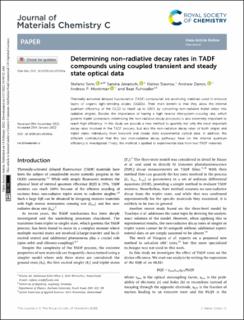Bitte benutzen Sie diese Kennung, um auf die Ressource zu verweisen:
https://doi.org/10.21256/zhaw-24644| Publikationstyp: | Beitrag in wissenschaftlicher Zeitschrift |
| Art der Begutachtung: | Peer review (Publikation) |
| Titel: | Determining non-radiative decay rates in TADF compounds using coupled transient and steady state optical data |
| Autor/-in: | Sem, Stefano Jenatsch, Sandra Stavrou, Kleitos Danos, Andrew Monkman, Andrew P. Ruhstaller, Beat |
| et. al: | No |
| DOI: | 10.1039/D1TC05594A 10.21256/zhaw-24644 |
| Erschienen in: | Journal of Materials Chemistry C |
| Band(Heft): | 10 |
| Heft: | 12 |
| Seite(n): | 4878 |
| Seiten bis: | 4885 |
| Erscheinungsdatum: | 14-Feb-2022 |
| Verlag / Hrsg. Institution: | Royal Society of Chemistry |
| ISSN: | 2050-7526 2050-7534 |
| Sprache: | Englisch |
| Schlagwörter: | OLED |
| Fachgebiet (DDC): | 621.3: Elektro-, Kommunikations-, Steuerungs- und Regelungstechnik |
| Zusammenfassung: | Thermally-activated delayed fluorescence (TADF) compounds are promising materials used in emissive layers of organic light-emitting diodes (OLEDs). Their main benefit is that they allow the internal quantum efficiency of the OLED to reach up to 100% by converting non-radiative triplet states into radiative singlets. Besides the importance of having a high reverse intersystem-crossing rate, which governs triplet conversion, minimizing the non-radiative decay processes is also extremely important to reach high efficiency. In this study we provide a new method to quantify not only the most important decay rates involved in the TADF process, but also the non-radiative decay rates of both singlet and triplet states individually from transient and steady state experimental optical data. In addition, the different contribution that the two non-radiative decay pathways have on the internal quantum efficiency is investigated. Finally, the method is applied to experimental data from two TADF materials. |
| URI: | https://digitalcollection.zhaw.ch/handle/11475/24644 |
| Volltext Version: | Publizierte Version |
| Lizenz (gemäss Verlagsvertrag): | CC BY-NC 4.0: Namensnennung - Nicht kommerziell 4.0 International |
| Departement: | School of Engineering |
| Organisationseinheit: | Institute of Computational Physics (ICP) |
| Enthalten in den Sammlungen: | Publikationen School of Engineering |
Dateien zu dieser Ressource:
| Datei | Beschreibung | Größe | Format | |
|---|---|---|---|---|
| 2022_Sem-etal_Determining-non-radiative-decay-rates-TADF-compounds.pdf | 2.88 MB | Adobe PDF |  Öffnen/Anzeigen |
Zur Langanzeige
Sem, S., Jenatsch, S., Stavrou, K., Danos, A., Monkman, A. P., & Ruhstaller, B. (2022). Determining non-radiative decay rates in TADF compounds using coupled transient and steady state optical data. Journal of Materials Chemistry C, 10(12), 4878–4885. https://doi.org/10.1039/D1TC05594A
Sem, S. et al. (2022) ‘Determining non-radiative decay rates in TADF compounds using coupled transient and steady state optical data’, Journal of Materials Chemistry C, 10(12), pp. 4878–4885. Available at: https://doi.org/10.1039/D1TC05594A.
S. Sem, S. Jenatsch, K. Stavrou, A. Danos, A. P. Monkman, and B. Ruhstaller, “Determining non-radiative decay rates in TADF compounds using coupled transient and steady state optical data,” Journal of Materials Chemistry C, vol. 10, no. 12, pp. 4878–4885, Feb. 2022, doi: 10.1039/D1TC05594A.
SEM, Stefano, Sandra JENATSCH, Kleitos STAVROU, Andrew DANOS, Andrew P. MONKMAN und Beat RUHSTALLER, 2022. Determining non-radiative decay rates in TADF compounds using coupled transient and steady state optical data. Journal of Materials Chemistry C. 14 Februar 2022. Bd. 10, Nr. 12, S. 4878–4885. DOI 10.1039/D1TC05594A
Sem, Stefano, Sandra Jenatsch, Kleitos Stavrou, Andrew Danos, Andrew P. Monkman, and Beat Ruhstaller. 2022. “Determining Non-Radiative Decay Rates in TADF Compounds Using Coupled Transient and Steady State Optical Data.” Journal of Materials Chemistry C 10 (12): 4878–85. https://doi.org/10.1039/D1TC05594A.
Sem, Stefano, et al. “Determining Non-Radiative Decay Rates in TADF Compounds Using Coupled Transient and Steady State Optical Data.” Journal of Materials Chemistry C, vol. 10, no. 12, Feb. 2022, pp. 4878–85, https://doi.org/10.1039/D1TC05594A.
Alle Ressourcen in diesem Repository sind urheberrechtlich geschützt, soweit nicht anderweitig angezeigt.